Discover the Mystical Beauty of Fushimi Inari Shrine in Kyoto: A Journey into Serenity
How to get to the Fusimi Inari Shrine In Kyoto
Getting to Fushimi Inari Shrine in Kyoto is relatively straightforward. Here’s how you can reach the shrine:
By Train: Take a train to the JR Inari Station on the JR Nara Line. From Kyoto Station, it’s a short ride of about five minutes. Once you arrive at JR Inari Station, follow the signs to the shrine. The entrance to Fushimi Inari Shrine is just a short walk from the station.
By Kyoto City Bus: You can also reach Fushimi Inari Shrine by taking a Kyoto City Bus. From Kyoto Station, take bus number 5 or 100 to Fushimi Inari Taisha-mae bus stop. The shrine is located a few steps away from the bus stop.
By Walking: If you’re staying in the vicinity of Kyoto Station or nearby areas, you can choose to walk to Fushimi Inari Shrine. The walk takes approximately 30-40 minutes and provides an opportunity to explore the surrounding neighborhoods.
Upon arriving at Fushimi Inari Shrine, you’ll see the iconic red torii gates that lead up to the main shrine complex. Follow the path and venture through the mesmerizing tunnel of thousands of torii gates as you ascend Mount Inari. Enjoy the serene atmosphere and take in the beauty of this sacred Shinto site.
Here’s a brief history about the Fushimi Inari Shrine in Kyoto
The Fushimi Inari Shrine, located in Kyoto, Japan, is one of the most important and revered Shinto shrines in the country. Its history dates back over a thousand years, with its origins tracing back to the early 8th century.
The shrine was established in 711 AD by the Hata clan, a prominent family in the region. Initially known as Hata-no-Iwaine Shrine, it was dedicated to the Shinto deity Inari, who is believed to be the god of rice, fertility, and prosperity. Inari is also regarded as the patron deity of business, merchants, and agriculture.
Over time, the shrine grew in popularity and received significant patronage from various individuals, including powerful samurai clans, noble families, and wealthy merchants. In the 14th century, the shrine was renamed Fushimi Inari after the area where it is located.
During the Edo period (1603-1868), Fushimi Inari Shrine gained immense support from the ruling Tokugawa shogunate. The shrine’s influence expanded, and it became a symbol of prosperity and protection for the people of Kyoto.
The iconic feature of the shrine, the thousands of torii gates that adorn the pathway up the sacred Mount Inari, began to be erected in the 17th century. These gates, donated by individuals and businesses seeking blessings and prosperity, have become a defining symbol of the shrine and a remarkable sight for visitors.
This is definitely one of the most unique and best things to do in Kyoto that is above and beyond the typical temple shrine experience to do in the city.
Visiting the Fushimi Inari Shrine early morning
Today I’m taking you on a visit to this amazing place In Kyoto, Japan. The temple at Fushimi Inari is very unique in Kyoto, it was created for those worshipping Inari – the god of rice and sake. Also Inari is known as the patron of business and manufacturing and their followers worshipped Inari. The Shrine at the base of the mountain (also called Inari) is lined with over 5,000 red tori gates that lead up the mountain and back downhill. Each red gate is a donation by a business in their name. It’s stunning to see all this from a distance and interesting to walk through.
Uphill climb aroud the Torii gates
Along the uphill climb, I happened into a priest with a large white parasol coming down the opposite direction. To good to pass up, I quickly took out my camera, focused and captured a few shots of this wonderful portrait coming down the series of Torii gates. Here’s the shot below, it’s one of my favorite captures by accident. I quietly followed the priest back to one of the lower temples to watch and see if any other moments might happen without my being in his way. – fairly mundane, but I enjoyed the procession of duties and took a few more shots and later continued up the hill to see if I can find a nice vista point of the area.
Weather and best time to visit the Fushimi Inari Shrine
Fushimi Inari Shrine in Kyoto can be visited throughout the year, but the best time to explore the shrine and its surroundings is during the spring and autumn seasons.
In spring (March to May), the weather in Kyoto is generally mild and pleasant. This is the time when cherry blossoms (sakura) bloom, creating a breathtakingly beautiful atmosphere. Witnessing the vibrant pink petals adorning the torii gates at Fushimi Inari Shrine is an enchanting experience.
Autumn (September to November) is another excellent time to visit Fushimi Inari Shrine. The weather is typically cool, and the foliage transforms into stunning hues of red, orange, and gold. The torii gates surrounded by the autumn colors provide a picturesque setting for exploration and photography.
Both seasons tend to attract a significant number of visitors, so it’s recommended to arrive early in the day to enjoy a more serene and peaceful experience. Weekdays also tend to be less crowded compared to weekends.
It’s important to note that Kyoto experiences a humid subtropical climate, with hot and humid summers and cold winters. Summers (June to August) can be hot and rainy, while winters (December to February) are chilly, with occasional snowfall.
Wandering the torii gate and gardens
Unfortunately, the stairs and torii kept continuing uphill and I realized that I was not going to make it all the way to the top because of a train I had to catch soon so I descended in a different direction downhill, discovering some peek a boo views of the green countryside. A few large fox statues were interspersed along the paths and I find out later that they represent the messengers with a key in their mouths to represent the rice granaries.
It’s almost meditative walking in between these torii gates, contemplative and quiet. While enjoying the views my mind seemed to focus internally to my own personal thoughts and concerns and nothing seemed to matter outside of this walk and concentration in the paths and stairs.
Before I exited the temple grounds I noticed this wall filled with thousands of origami paper cranes. I later find out that each strand contains one thousand paper cranes used as good luck gestures at weddings and new infants wishing for 1000 years of happiness and prosperity to the recipients.
What else to visit near the Fushimi Inari Sharine
Near Fushimi Inari Shrine, there are several other attractions and points of interest that you can visit to enhance your Kyoto experience. Here are some notable places to explore:
Tofuku-ji Temple: Located within walking distance from Fushimi Inari Shrine, Tofuku-ji is a renowned Zen Buddhist temple known for its beautiful gardens and impressive architecture. The temple is particularly famous for its stunning autumn foliage, attracting numerous visitors during the fall season.
Gion District: A short train or bus ride away from Fushimi Inari Shrine, Gion is Kyoto’s famous geisha district. Take a stroll through its traditional streets lined with wooden machiya houses, visit historic tea houses, and keep an eye out for geisha and maiko (apprentice geisha) who may be spotted in the area.
Kiyomizu-dera Temple: One of Kyoto’s most iconic landmarks, Kiyomizu-dera is a UNESCO World Heritage site. The temple offers breathtaking views of the city and features a wooden terrace built on stilts, providing a stunning vantage point. It’s especially popular during the cherry blossom and autumn seasons.
Nijo Castle: Explore the grand Nijo Castle, a UNESCO World Heritage site known for its historical significance and beautiful gardens. The castle complex features opulent interiors, intricate woodwork, and the famous “nightingale floors” designed to chirp when walked upon to detect intruders.
Arashiyama Bamboo Grove: Head west of Kyoto to the Arashiyama district, where you’ll find the enchanting Bamboo Grove. Walk through the towering bamboo stalks, creating a serene and otherworldly atmosphere. Visit the nearby Tenryu-ji Temple and the scenic Togetsukyo Bridge for additional sights in the area.
Kinkaku-ji (Golden Pavilion): Take a trip to Kinkaku-ji, also known as the Golden Pavilion, a stunning Zen Buddhist temple covered in gold leaf. Set in a tranquil garden, the temple reflects beautifully on the surrounding pond, creating a mesmerizing sight.
Inside tips to visiting Fushimi Inari Shrine in Kyoto
Visiting Fushimi Inari Shrine in Kyoto can be an incredible experience, but it’s helpful to be prepared to make the most of your visit. Here are some inside tips to enhance your trip:
Early Bird Advantage: Fushimi Inari is one of Kyoto’s most popular attractions, and it can get crowded during peak hours. To avoid the crowds and have a more serene experience, consider arriving early in the morning. The shrine opens around sunrise, and you’ll have a better chance of exploring the torii gates without many other visitors.
Comfortable Footwear: Be prepared for a lot of walking and stair climbing. The main path up the mountain to the inner shrine is about 4 kilometers long and includes both paved areas and natural trails. Wear comfortable shoes to ensure a pleasant journey.
Weather and Attire: Check the weather forecast before your visit and dress accordingly. Kyoto can be quite hot and humid during the summer, so wear lightweight and breathable clothing. Don’t forget to bring sunscreen, a hat, and a reusable water bottle.
Avoid Weekends and Holidays: If possible, try to visit Fushimi Inari on weekdays, as weekends and national holidays tend to be more crowded with both tourists and locals.
Explore Beyond the Main Path: While the iconic tunnel of torii gates is the most famous part of Fushimi Inari, don’t be afraid to explore the side paths and smaller shrines along the way. These less-visited areas often offer beautiful views and a more peaceful atmosphere.
Photography Tips: If you want to take photos without crowds in the background, consider bringing a tripod and taking long-exposure shots early in the morning or during sunset.
Nighttime Visits: Fushimi Inari is open 24/7, and visiting at night can provide a unique and mystical experience. However, be aware that the trails can be dark, so carry a flashlight or use your phone’s torch function.
Try Local Food: After your visit, explore the surrounding streets where you’ll find various food stalls and small restaurants. Don’t miss the opportunity to try some local delicacies, like Yatsuhashi (a popular Kyoto sweet) or some street food favorites.
Respectful Behavior: Remember that Fushimi Inari is an active religious site. Be respectful of the shrine, its visitors, and the customs. Avoid making loud noises, and if you encounter any religious ceremonies, maintain a distance and observe quietly.
Take Your Time: Finally, don’t rush your visit. Fushimi Inari offers a unique atmosphere that is best appreciated when you take your time to explore, soak in the surroundings, and appreciate the spiritual ambiance.
By following these tips, you’ll have a more enjoyable and memorable experience at Fushimi Inari Shrine in Kyoto. Enjoy your visit!
Final Thoughts
It was a fun visit to see the Fushimi Inari Shrine in Kyoto, hope you enjoyed the tour for Travel Photo Mondays. Please come and visit the blogs below for more interesting places and photographs from around the world today.
Please check out these other posts on visiting Kyoto, Japan
Beautiful gardens of Kyoto, Japan
Visiting the Silver Pavilion in Kyoto, Japan
Conclusion to visiting the Fushimi Inari Shrine in Kyoto
In conclusion, visiting the Fushimi Inari Shrine in Kyoto is a truly remarkable and unforgettable experience. This sacred site is not only one of Japan’s most iconic landmarks but also holds deep cultural and spiritual significance.
The Fushimi Inari Shrine is renowned for its thousands of vibrant orange torii gates that form a mesmerizing pathway through the forested hills. Walking through this tunnel of gates is an awe-inspiring journey that captivates visitors with its ethereal beauty and tranquil atmosphere.
Aside from the striking visual appeal, the shrine offers a profound spiritual retreat. Fushimi Inari is dedicated to the Shinto god of rice and prosperity, Inari. Many visitors come here to seek blessings for business ventures, success, and good fortune. The serene ambiance, accompanied by the sounds of nature and the soft rustling of the gates, creates a sense of peace and introspection.
If you like this post on Fushimi Inari Shrine in Kyoto, please consider subscribing to the blog by email below – also I appreciate it if you could share this post with any of the social media buttons located below and around the post, thank you!

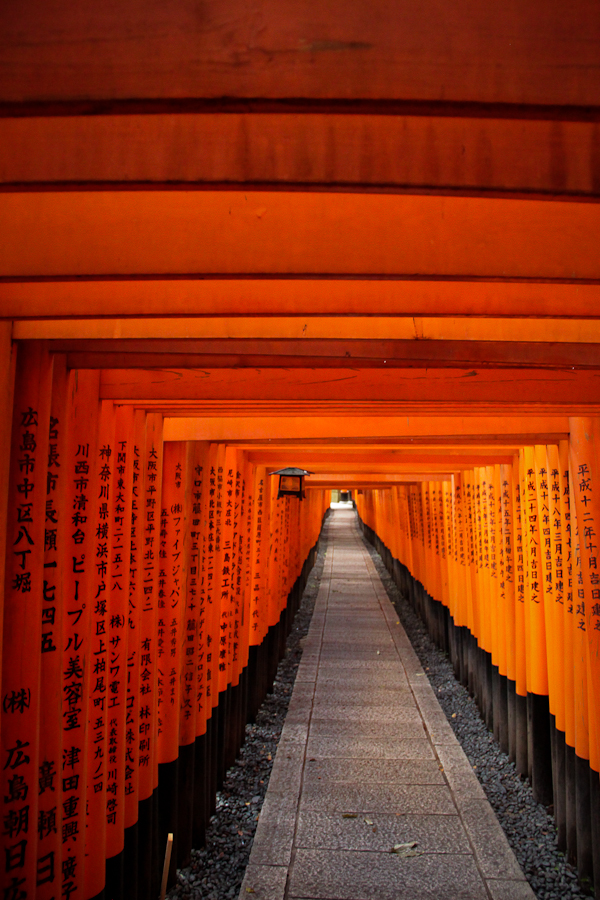
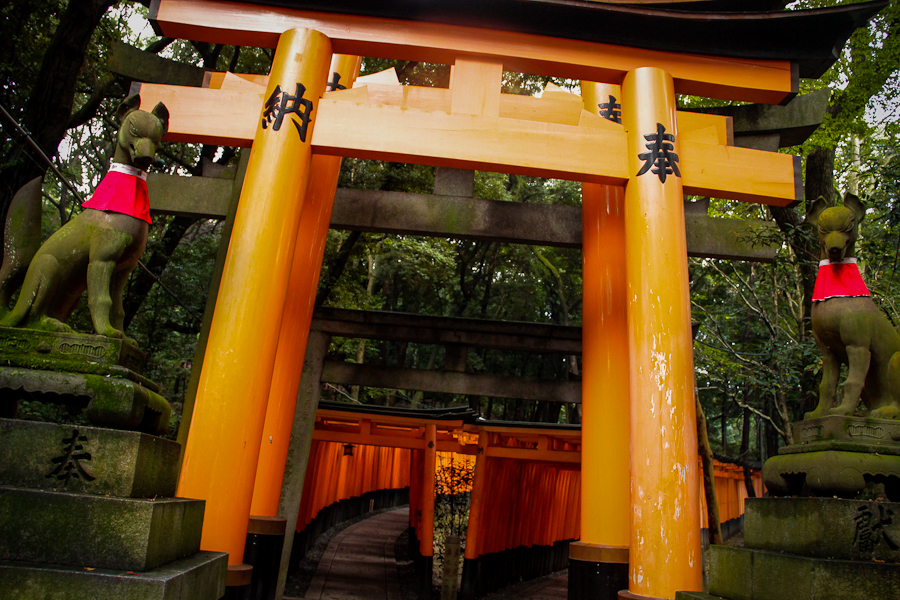
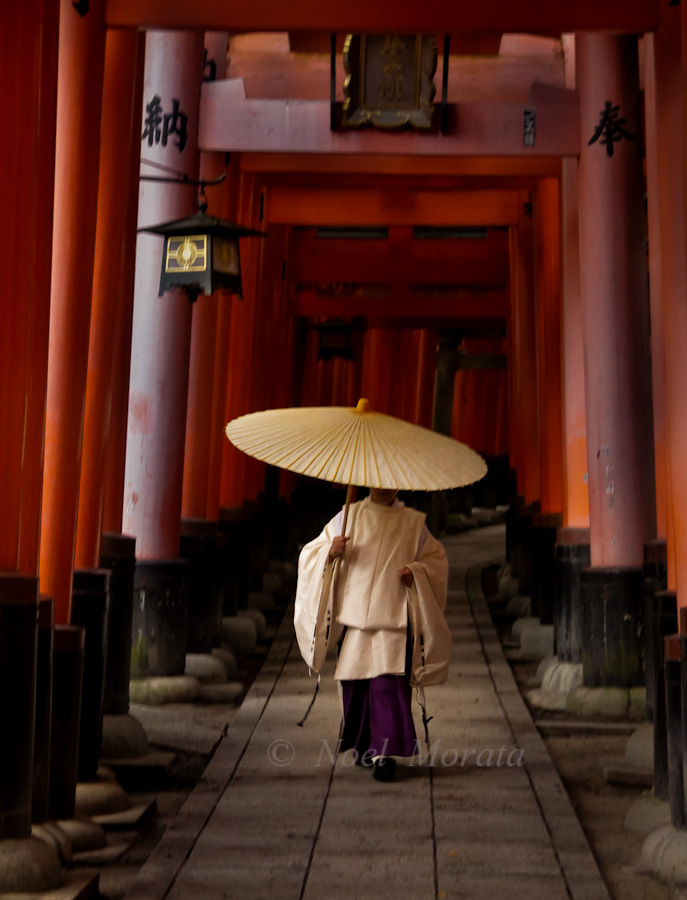
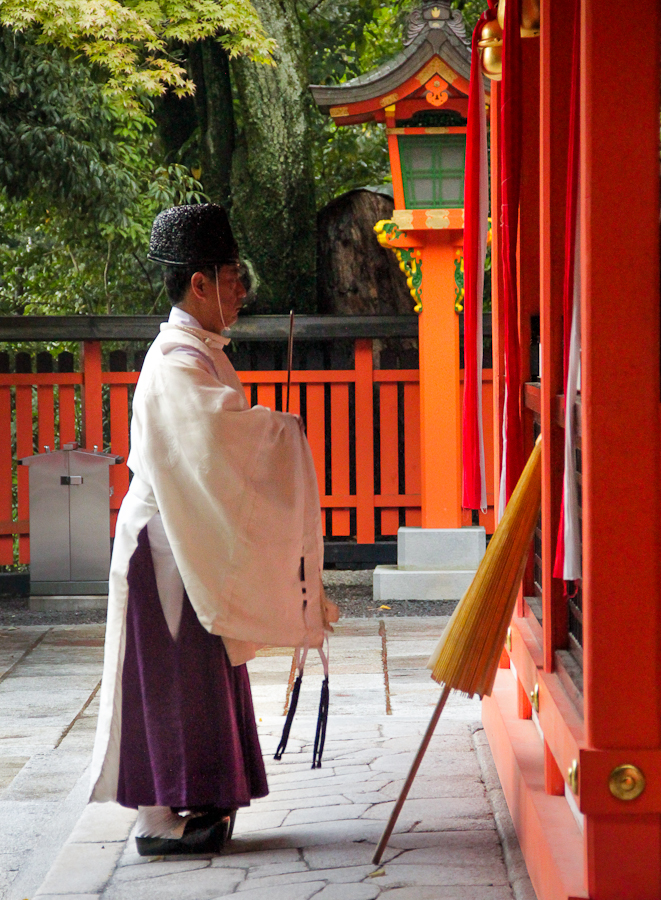
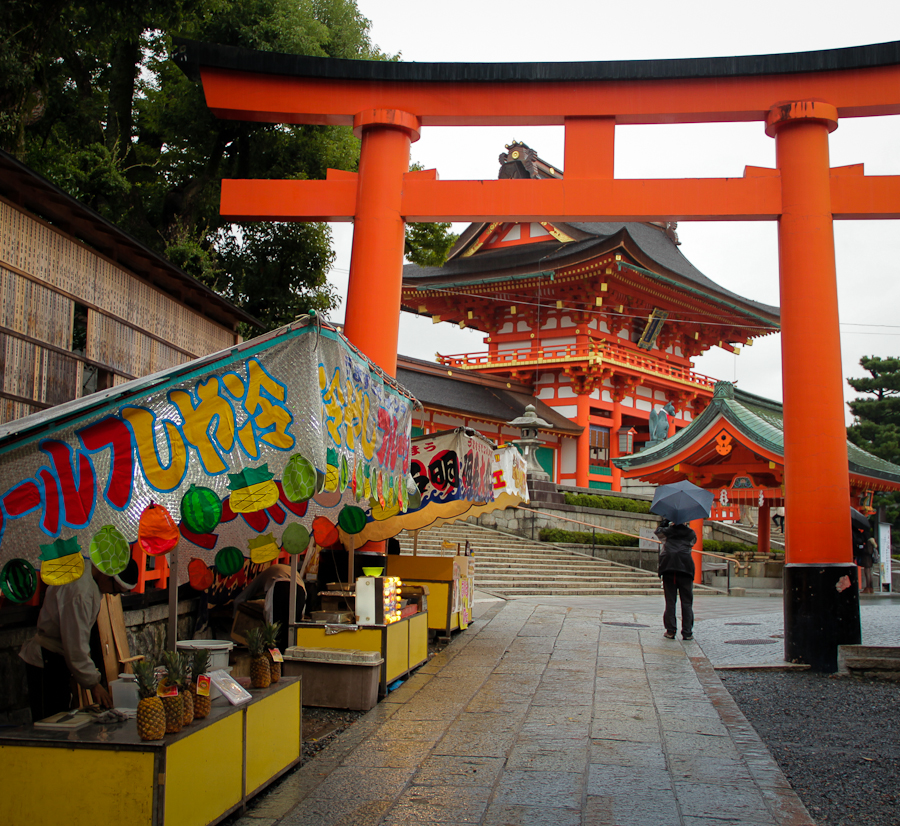
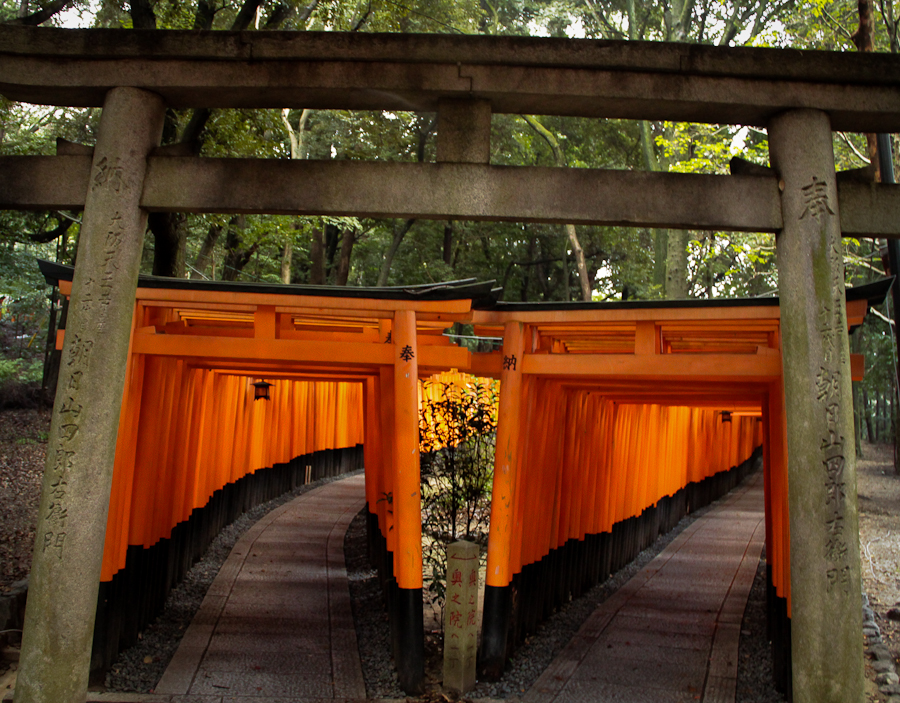
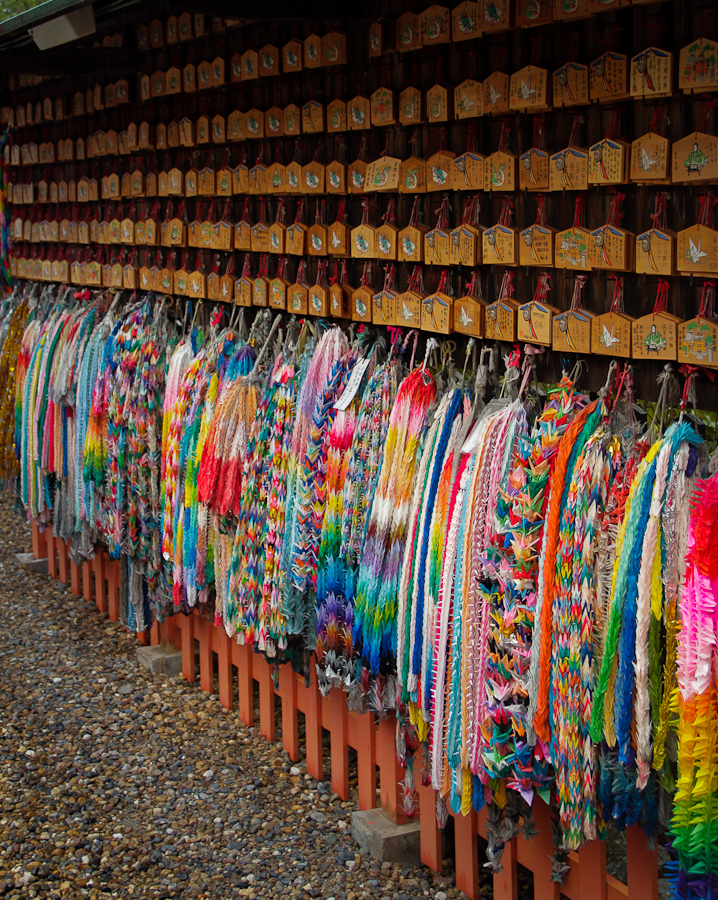
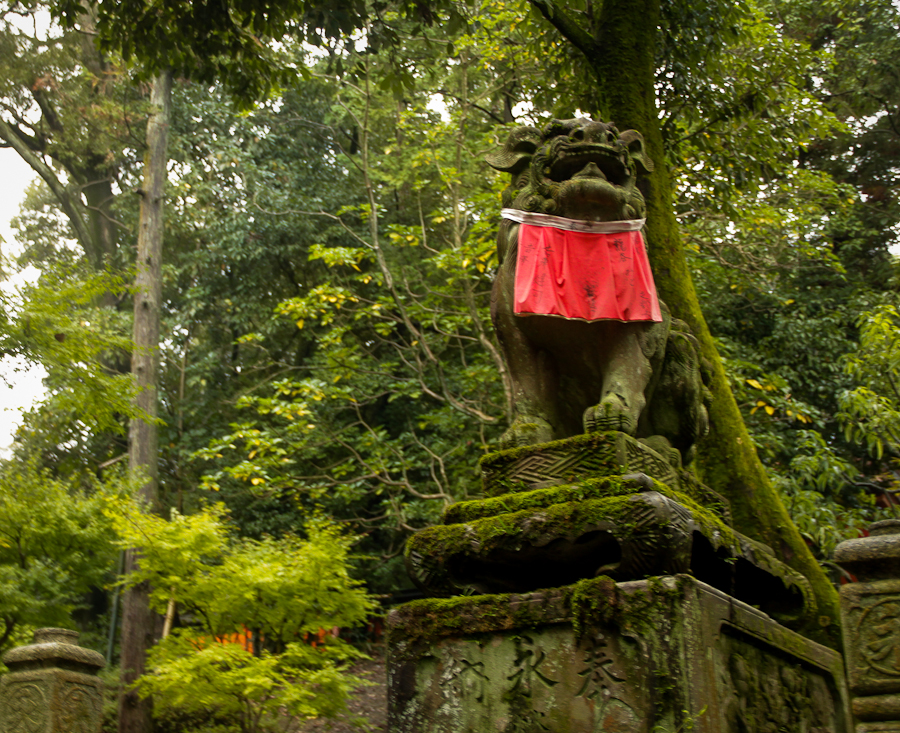

Stunningly beautiful photos (as usual), Noel!
Stunning photos! I love the colors and my favorite is the one with the priest.
I love Kyoto and its temples. You have captured it so well in these photos. I particularly like the cranes and the “ema” plaques: http://travelwithintent.com/2013/01/27/ema-japan-love-luck/
Those origami paper cranes are amazing, Joel! This definitely not your every day fox, either 🙂
Those red tori details – splendid. A blast of color to brighten the start of our week. Thank you…
The colors are so vivid, it looks amazing. How much time would it take to make all of those paper cranes? Oh my!
The gates are amazingly colorful. I love your photo of the priest – a perfect timing and capture!
Fabulous photo of all the red tori gates. I never got as far as Kyoto when I visited Japan. It’s somewhere I would love to visit.
Here are my photos from Turkey: http://traveller2006.wordpress.com/2013/11/04/travel-monday-19-kayakoy/
Just to let you know I’m continuing on my wordpress blog!
Just to let you know I deleted the blogspot blog and am continuing at my wordpress blog! Happy week:)
Beautiful photos, Noel! Those colors are so vibrant they almost ache. I too couldn’t find the link or I would have joined in today – finally back on terra firma!
You do have such wonderful photos – I love them.
just beautiful photos, the blast of color in vigorating
is there a link up this week Noel?
What an interesting place, Noel, and gorgeous pictures, as always. Thanks for sharing. I don’t see the link up, I was going to share my Gargoyles of Biltmore Estate post…
Great photos:)
what an amazing place. The colours are amazing. I love your image of the priest – a wonderful portrait.
Have a great week and thank you for hosting.
This was my favorite place to visit in Kyoto. I could have spent longer there except it was beginning to get too dark to walk around. Being able to follow along with a priest certainly lends to the experience. Instead of a priest, I stumbled upon a bridal portrait session. Your photos are supreme, and, I will admit, better than the ones I took.
I was at my parents’ this weekend and showed all your recent Japan posts to my mom and she enjoyed them very much. Again, thanks for your amazing photographies!
Amazing pictures, amazing places. The colors are so rich! And the architecture. Everything.